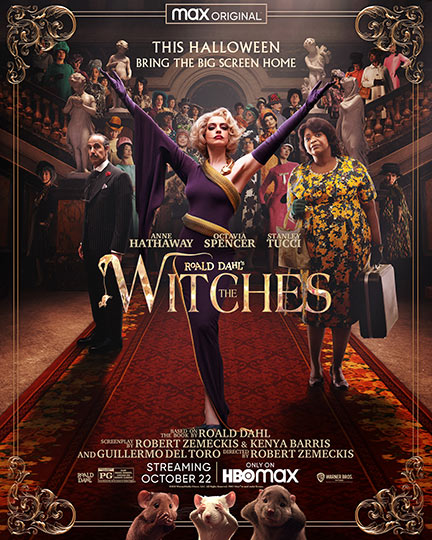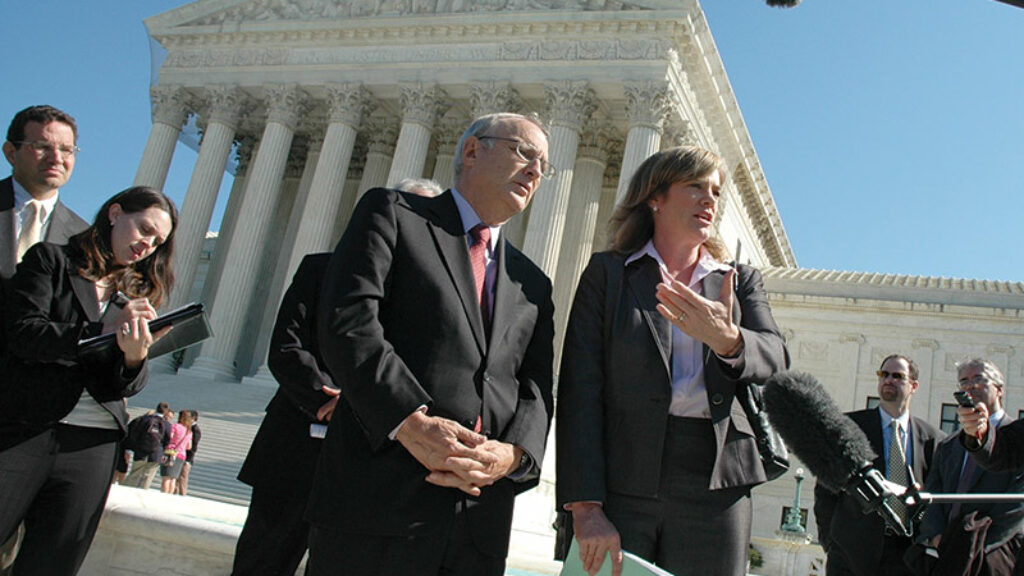Who Doesn’t Love Roald Dahl?
There’s nothing quite like the realization that what you thought was an empowering work of art is actually a 200-page exercise in trolling. It took me more than 30 years to figure out that I’d been trolled by Roald Dahl.
Dahl, who dominated juvenile publishing when I was growing up, revealed himself late in his career to be a vicious antisemite, who thought “powerful American Jewish bankers” ran the US government. He told the New Statesman that “there is a trait in the Jewish character that does provoke animosity, maybe it’s a kind of lack of generosity towards non-Jews. I mean, there is always a reason why anti-anything crops up anywhere; even a stinker like Hitler didn’t just pick on them for no reason.” This was in 1983, the year in which Dahl published The Witches, his 13th novel for children.
Apparently, Dahl had been an antisemite his entire life, but it didn’t prevent him from being essentially canonized after his death in 1990, and it didn’t much affect my thoughts about him either. I had adored his books as a child, and I’ve never taken much interest in the now-obligatory grunt work of connecting artists’ personalities (often horrible) with their works (sometimes great). And although Dahl was not only an antisemite but also (and even more damningly these days) a misogynist and a racist, he hasn’t been canceled yet. Who doesn’t love Roald Dahl, or at least his stories?

Hollywood certainly does. The most recent Dahl adaptation, which began streaming on HBO Max this Halloween season, is called Roald Dahl’s The Witches (note the value of the authorial brand), directed and written by Robert Zemeckis, with the help of two younger Hollywood powerhouses, Kenya Barris and Guillermo del Toro. It stars the high wattage Octavia Spencer, perhaps best known for her Oscar-winning role in The Help, and A-lister Anne Hathaway, not to mention the voice of the comedian Chris Rock. In fact, this is the second big-budget version of The Witches, the first having been a 1990 film starring Anjelica Huston.
But The Witches was on my mind long before I’d heard about the new movie. It was one of my favorite books when I was a child, one I read repeatedly and pressed into the hands of friends. I was eager to share it with my own children and hesitated only because, as a child, I’d also found it somewhat terrifying. But when I read it aloud to my eight-year-old son last month, I discovered that it was far more terrifying than I remembered, and for entirely different reasons.
The key to Dahl’s success as a children’s author lay in how he pitted children against adults, making children into a beloved underdog class whose moral victory lay in vanquishing their powerful exploiters. His heroes are blameless boys and girls tortured by diabolically abusive adults, whom they destroy in outrageous revenge sequences of the sort even the most fortunate child occasionally fantasizes about. In James and the Giant Peach, for instance, the orphaned James, enslaved by his villainous aunts, squashes them to death with the titular fruit. In Matilda, a kindergartener uses magic powers to terrorize a school principal who routinely locks children in a nail-studded closet. In Charlie and the Chocolate Factory, the starving Charlie, living in the sort of poverty that would make Oliver Twist qualify as a one-percenter, inherits a fantastical candy factory—but only after a book-length morality play in which wealthy children and their entitled parents are absurdly tortured and maimed. In George’s Marvelous Medicine, a boy forced to care for his heartless grandmother concocts a potion that makes her shrink and disappear.
In short, Dahl is like a modern Charles Dickens, except instead of social justice and spiritual redemption, Dahl’s books offer only revenge. Kids, like all emotionally and morally stunted people, eat this stuff up. Dahl tapped into something primal and hideous in the human psyche: the desire of disenfranchised people to feel righteous precisely by demonizing others. As a kid, I bought this too. The sheer sadism of it went right over my head until I shared these books with my children and saw how I’d been punked. And The Witches was the worst.
The Witches is about a boy who is orphaned in the opening chapter—pity points are always crucial for Dahl—and then adopted by his loving Grandmamma, a kindly old lady who fills him in on a little-known scourge. Witches, she explains, are real. They are demons disguised as women, and their sole purpose is to entrap and destroy innocent children through their diabolical magic. One unfortunate boy, for example, went off with a witch and returned unharmed—but later hardened into a stone statue. After vanishing with a witch, a girl reappeared only in a landscape painting in her family’s home, changing positions whenever the family wasn’t watching and even aging as years passed. (That one haunted me for decades.) Other children are “disappeared” in ways worthy of an Argentine junta. Kids better watch out.
One summer on a beach vacation with Grandmamma, our hero wanders into a hotel conference room occupied by a group calling itself the “Royal Society for the Prevention of Cruelty to Children.” In fact, it is a coven of witches discussing their latest plan, a potion designed to turn children into mice. They discover the boy and immediately mouse-ify him, but now that our talking mouse hero knows where they keep their potions, he and Grandmamma hatch a clever plot to administer them to the witches themselves. Hijinks ensue, evil is vanquished, and although the narrator remains a mouse, he doesn’t mind. He and Grandmamma embark on a crusade to take out the witches of the world, and he never has to go to school again.
The book chimed perfectly with the stories of “stranger danger” that other 1980s children and I were constantly fed in state-mandated school curricula, but it made that threat delightfully preposterous—and manageable since all one had to do was believe that certain adults were actually demons with recognizable tells. It was a highly rewarding fantasy. After all, it was clear to me, as it was to every young reader, that even adults who didn’t molest children in shopping malls were nonetheless conspiring against us, making us do dehumanizing tasks like making beds and taking tests. The book was empowering. With its frisson of secret knowledge, it made us feel righteous and invincible. Unfortunately, revisiting it as an adult revealed that the book was cribbed from the Protocols of the Elders of Zion—and helped me understand, for perhaps the first time, antisemitism’s seductive appeal.
“Witches,” Grandmamma explains, “are not actually women at all . . . They are demons in human shape.” How do you spot one? Well, since they’re demons, they have toeless hooves instead of feet and claws instead of fingers, disguised by fashionable shoes and gloves. You can’t spot those, but you can spot their “larger nose-holes than ordinary people” (the better to smell you with, my dear). But the real tell, of course, is that witches are bald—which is why a witch always wears “a first-class wig,” which she puts “straight on her naked scalp.”
As I read this aloud to my enthralled son, it was hard to miss how much these witches resembled women in, say, Stamford Hill (the London version of Borough Park). It was also hard to miss how much they resembled caricatures from Der Stürmer or a medieval blood libel. Was I overinterpreting?
You be the judge: “Wherever you find people, you find witches,” Grandmamma tells her innocent grandchild. “There is a Secret Society of Witches in every country. . . . An English witch, for example, will know all the other witches in England.” If this was too subtle, Grandmamma clarifies: “Once a year, the witches of each separate country hold their own secret meeting. They all get together in one place to receive a lecture from The Grand High Witch of All the World.” The boy’s question about this fun fact is, at this point, predictable: “Is she rich?”
Grandmamma replies, “She’s rolling. Simply rolling in money. Rumour has it that there is a machine in her headquarters which is exactly like the machine the government uses to print the bank-notes you and I use.” The boy then asks, as any normal child would, “What about foreign money?” You already know the answer: “Those machines can make Chinese money if you want them to.” Here, the boy turns skeptical: “If nobody has ever seen the Grand High Witch, how can you be so sure she exists?” Grandmamma counters, “Nobody has seen the Devil, but we know he exists.” All of this isn’t merely true, we are told, but “the gospel truth” (the italics are Dahl’s). After all, Grandmamma “went to church every morning of the week and she said grace before every meal, and somebody who did that would never tell lies.” As Grandmamma warns her dear boy, “All you can do is cross your heart and pray to heaven.”
Alas, crossing his heart and praying to heaven doesn’t protect our hero from his encounter with the Elders of Witchdom, at which point Dahl drops all pretense. The Grand High Witch, we learn, “had a peculiar way of speaking. There was some sort of a foreign accent there, something harsh and guttural, and she seemed to have trouble pronouncing the letter w. As well as that, she did something funny with the letter r. She would roll it round and round her mouth.” The Grand High Witch, in her Yiddish accent, explains to her secret society how they will lure England’s children by buying high-end sweet shops and poisoning the candy, since “Money is not a prrroblem to us vitches as you know very well. I have brrrought with me six trrrunks stuffed full of Inklish bank-notes, all new and crrrisp” (italics mine).
Few children can resist the lure of witches. My son loved the book so much that he wanted to see the movie. Perhaps you are wondering: is the 2020 Hollywood version, whose creators unsurprisingly included plenty of Jews, antisemitic? The short answer is no, or not exactly, but that’s also the wrong question.
Adapting from a source this hideous was never going to be easy or entirely uncontroversial, and the new film has already been slammed for portraying limb differences as evil (instead of the claws mentioned in the book, the film’s witches are depicted with missing fingers). Despite that tone-deaf choice, it’s clear that the filmmakers were aware of the book’s larger problems. To their credit, they knew they had to fix something, and they went big: instead of contemporary England, Roald Dahl’s The Witches takes place in 1968 Alabama, and the protagonist and his grandmother are Black (Octavia Spencer’s Grandmamma is even a voodoo healer). Unlike the 1990 movie, the witches no longer have big noses and are, in fact, racially diverse. At first, this does seem poised to dilute some of the book’s inherent awfulness: when a Black witch attacked the protagonist in an early scene, I had high hopes for a story where “evil” was depicted solely through Marvel Universe methods of pancake makeup and special effects. But that scene proved to be half-hearted tokenism, since the rest of the film focuses almost entirely on, to use the current term, white-presenting witches—and most tellingly, what really distinguishes witches in this film is that they are rich. As we watch a flashback of the lily-white and fabulously dressed Anne Hathaway as the Grand High Witch attacking an impoverished Black child in a 1920s Alabama shantytown, Grandmamma tells us that “witches always prey on the poor.”
This class warfare idea is utterly absent from Dahl’s book, but it perhaps unintentionally provides a trendy update to his rather old-school racial antisemitism: the idea that a secret society of fantastically wealthy “global elites”—often, but not inevitably, Jews—prey on the poor. This means that bigotry against them, rather than being retrograde, is, in fact, a fresh and righteous way of “punching up.” Instead of just protecting innocent children, this new Grandmamma now also shares her truth to defend the downtrodden, like every righteous nutjob tweeting about the Rothschilds or George Soros. In the book, nothing much happens with the Grand High Witch’s counterfeit cash. But here Grandmamma commandeers it at the film’s triumphant end and hands out hundred-dollar bills to the hotel’s exploited Black employees.
If this sounds tedious, it is. Roald Dahl’s The Witches is wretched less because of the book’s wretched premise than because it is a conventionally lousy children’s movie, full of Hollywood pieties (in the climactic scene, Grandmamma actually lectures the Grand High Witch about the Power of Love), canned stereotypes and recycled animation. That doesn’t mean kids won’t love it, of course. As Hollywood knows well, everyone loves a good conspiracy theory—and that’s the problem.
My kids laughed their way through the movie’s animated mice and cookie-cutter triumphs, enjoying everything that conventional children’s stories do best—reinforce their audience’s expectations, vanquish villains, and make powerless people feel superior. Conspiracy theories make for great stories, but in an era when a nontrivial proportion of the American electorate apparently believes in the QAnon conspiracy theory that a secret cabal of satanic pedophiles preys on American children and the country, I couldn’t help feeling that this film was, at the very least, ill-timed.
It is so easy, after all, to believe in a conspiracy, so self-indulgent, so appealing—and, as I now finally understood, so much fun. Watching this mediocre and unremarkable movie left me shockingly ill at ease, precisely because it was so mediocre and unremarkable. My discomfort was compounded by the knowledge that the eight-year-old me would have loved it too, not knowing any better. Few children do. In the elaborate, magical long game of luring innocents into handing over their hearts, it turns out that the Grand High Witch was actually Roald Dahl.
Comments
You must log in to comment Log In
Suggested Reading

Forging an Identity
How did a young Sephardi polyglot from Constantinople transform himself in Mexican society?
Awe and Joy
S. Y. Agnon curated a stunning anthology of Jewish texts, published later in English as Days of Awe. In his introduction to the anthology, the eminent scholar Judah Goldin grappled with the idea of awe—and so does this author.

Fictional Revisionism
The first time I picked up Joshua Cohen’s new novel, The Netanyahus: An Account of a Minor and Ultimately Even Negligible Episode in the History of a Very Famous Family, I put it down when I reached page eighty-four.

The First Amendment and the Vocabulary of Freedom
Oral arguments in a case involving two Catholic schools sometimes sounded less like a jurisprudential clash over the First Amendment than a synagogue kiddush.
Carole Stock
Dara, thank you so much for this enlightening and somewhat disturbing review. Years ago I wrote a lengthy question to a Rabbi in which I posed the question - 'The Singer or the Song'? As a lover and teacher of literature and an avid reader I had of course encouraged my children to reap the pleasure of books. Like you my children and now my grandchildren had all read and enjoyed the books of Roald Dahl. Disturbed by the fact that so many of my beloved poets and authors were virulent anti Semites I asked - which is more important - the singer or the song (and this surely relates to all manner of communication or written work). As an adult we are able to separate the two but are we able to do so as children and how therefore as parents do we respond if at all. Could I justify encouraging children to read the works of such a man or woman without giving insight into the man behind the works. I did not receive a definitive answer . Perhaps there is no definitive answer but I was pleased that you too had shared my concern.
gershon hepner
WHAT WE’RE MORE TOLERANT OF THAN ANTISEMITISM
Most popular, the books by Roald Dahl are basically about revenge by clever children of adults
who have in many most intriguing ways abused them,
in contrast to the spiritually redeeming books of Dickens, based instead on social justice.
The fact that, since he was an antisemite, we should all treat Roald Dahl with great disgust is
ignored by his admirers because he’s amused them,
and antisemitism, just like child abuse, has long been popular in many of the grown-ups’ cults.
We still are far more tolerant of it than of misogyny,
and of abuse by spiritual redeemers of our progeny.
Judy Snitzer
I loved Roald Dahls books when I read them to my children and loved the first movie of The Witches with Anjelica Huston. The fact that I found such delight in these books makes Dara Horns case for the allure of antisemitism much more believable and even understandable to me. I wonder if modern analysts of fairy tales would concur with her.
Mandi Abrahams
Why equivocate? Dahl should have been removed from school libraries and curriculae years ago. He always gave me the creeps and even as a bookseller, I never encouraged his reading